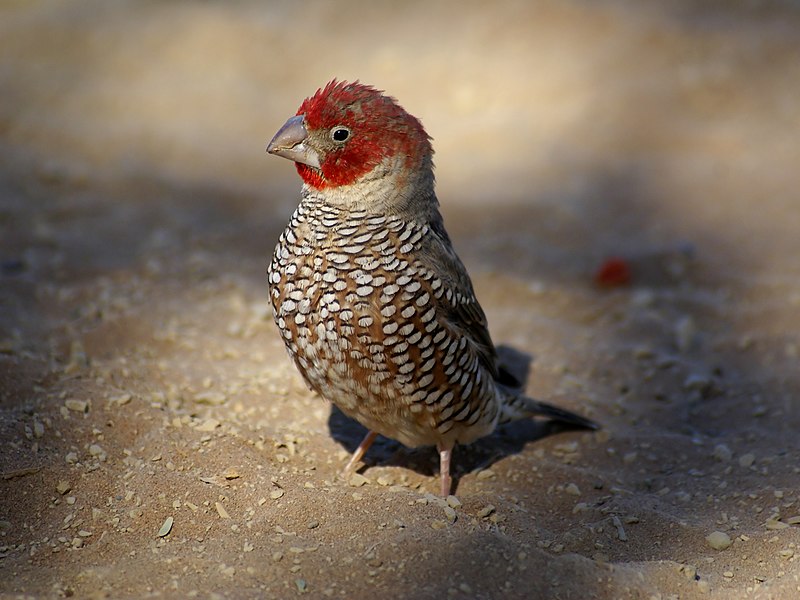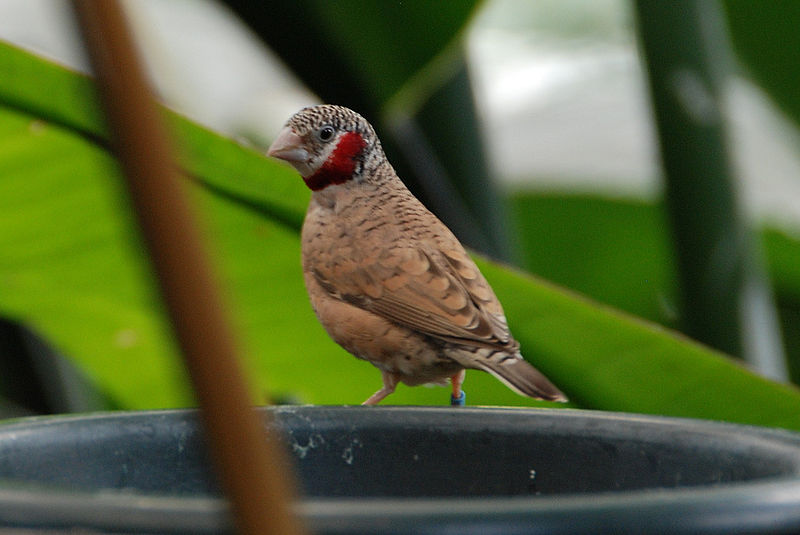 The Red-Headed Finch (Amadina erythrocephala) somewhat resembles its more familiar cousin, the Cutthroat Finch, but is a bit larger and, in my opinion, even more striking in appearance. It is also a more reliable breeder than the Cutthroat and, if properly cared for, may live for over a decade. Many keepers report that their Red-Headed Finches mimic sounds, and the songs of other birds, quite well.
The Red-Headed Finch (Amadina erythrocephala) somewhat resembles its more familiar cousin, the Cutthroat Finch, but is a bit larger and, in my opinion, even more striking in appearance. It is also a more reliable breeder than the Cutthroat and, if properly cared for, may live for over a decade. Many keepers report that their Red-Headed Finches mimic sounds, and the songs of other birds, quite well.
Description
In place of the Cutthroat Finch’s attractive splash of color (please see photo), the male has a bright red or crimson head, and his breast is beautifully marked with black-rimmed white spots. Females lack the red head and are more somberly-colored in general.
The alternate common name, Paradise Sparrow, is apt – in part due to the brilliant plumage but also because this 5 ¼ inch-long bird is stoutly built, and puts one more in mind of a sparrow than a typical finch.
Natural History
The Red-Headed Finch inhabits southern Africa, where it ranges from Angola through Zimbabwe to South Africa.
It is a bird of open thorn-scrub habitats and brushy veldts, but also frequents farms, villages and even cities. Red-Headed Finches breed colonially, utilizing abandoned weaver nests, tree cavities, and holes in building walls.
Housing
Red-Headed Finches may be kept in large finch cages or outdoor aviaries. Although they nest in colonies, only a single breeding pair should be kept in a cage. In an aviary or flight cage, multiple pairs may be housed together, but their behavior should be closely monitored for signs of aggression.
In spacious quarters, Red-Headed Finches may be kept with Java Rice Birds, Spice Finches, Button Quails and similar birds. They also get along with Cutthroat Finches, but will interbreed with them and produce fertile hybrids.
Diet
 A thick, conical bill allows the Red-Headed Finch to consume a wide range of seeds. Those I’ve cared for did well on finch seed mixes that had been bolstered by a high-grade parakeet diet.
A thick, conical bill allows the Red-Headed Finch to consume a wide range of seeds. Those I’ve cared for did well on finch seed mixes that had been bolstered by a high-grade parakeet diet.
Millet sprays hung from perches will keep both you and your birds occupied and entertained for hours.
Small live insects (mealworms, waxworms, crickets), Egg Food and softbill pellets, while not essential outside of the breeding season, should be provided several times weekly; silkworms and other canned insects should be used to add variety to the diet.
Fresh sprouts, carrot tops, and small amounts of chopped kale, dandelion and other greens will round out the diet.
Increased amounts of protein-based foods and fresh produce are necessary during the breeding season, and for parents with chicks.
Grit and cuttlebone should always be available.
Breeding
In common with some other birds native to harsh habitats, Red-Headed Finches may be stimulated to breed at any time of the year if a nest box is provided. Many owners have found that they are sometimes “too willing” to attempt nesting – starting out when given a box but failing due to age, aggression, poor condition or other factors.
While these prolific birds will utilize nearly any type of box, the natural situation is to weave an elaborate, globular nest with a tunnel-like entrance way. Superior results will be achieved if they are provided with a parakeet or large finch nest box and an ample supply of dry grass and nesting hair.
Both parents incubate the 3-6 eggs for 12-13 days. They are quick to abandon the nest if disturbed, so resist the urge to check on their progress. The chicks fledge on day 21-24, and are usually sexually mature within 6 months. However, breeding should be delayed until they are at least 1 year of age.
Further Reading
Video: pair of Red-Headed Finches
Red-Headed Finch Natural History, and great photos
Cutthroat Finch Study (desert-adapted population)
Red-headed Finch image referenced from wikipedia and originally posted by Hans Hillewaert
Cutthroat Finch image referenced from wikipedia and originally posted by Daniel Crookston
 That Bird Blog – Bird Care and History for Pet Birds
That Bird Blog – Bird Care and History for Pet Birds




Hello Frank,
Crazy story, my fiance and I had moved our live Christmas tree out onto the balcony of our condo in order to lower it over the railing and dispose of it…then someone wanted it for kindling, so we left it there a while longer than we had planned. we noticed a pair of Red Headed Finches (my favorite wild bird) were spending a lot of time on our balcony, and realized, yup, they were building a nest. So we let the whole habitat be and enjoyed their activities and comings and goings. Then another pair started hanging around, and we had a birdie-condo of our own – the first nest had 3 eggs that hatched and flew away seemingly just fine. The second nest had 5 eggs. And then the HOA got involved and insisted we get rid of the tree or face fines, even once they knew it would put the birdie family in jeopardy…boo. We had to get rid of the tree, but we sawed off the nest portion, knowing it was a risk that it would be abandoned. It has, but we have constructed an incubator and seem upon candling to have 4-5 viable eggs…question is…how to proceed from here? I cannot just let them die by HOA interference…we are committed to raising them even if we go back to the midnight feedings we thought we had left behind years ago…any help and advice would be appreciated. Mom was sitting the nest starting Thursday night (4 nights ago) and was run off on Friday night (3 nights ago) we realized she was not coming back last night and started incubation. Candled tonight and see veining and definite embryonic shapes…please help?
HI,
Well, that is a good story!….unfortunately baby house finches are very difficult to hand-rear, in terms of proper nutrition, avoiding bacterial disease of the crop etc. It has been done using a diet comprised mainly of soaked Purina cat chow, hard boiled eggs and chopped mealworms, and with a mix of Kaytee hand rearing formula and cat chow. Sometimes all works out if you feed often, keep them warm…but to see what’s involved if you want to cover all the bases, please see this article (article is for domestic species, yours would need much more protein than diet described there). The best option would be to give the eggs or young to a licensed wildlife rehabilitator…those specializing in birds have this down to a science, and are also good at adjusting young to life outdoors. Please let me know if you need help in finding someone in your area.
best, Frank
Frank,
Any referral would be a good option to have, I think.
Thank you so much!
Hi,
My pleasure. Let me know what state/region you’re in so I can check for a local re-habber, Frank